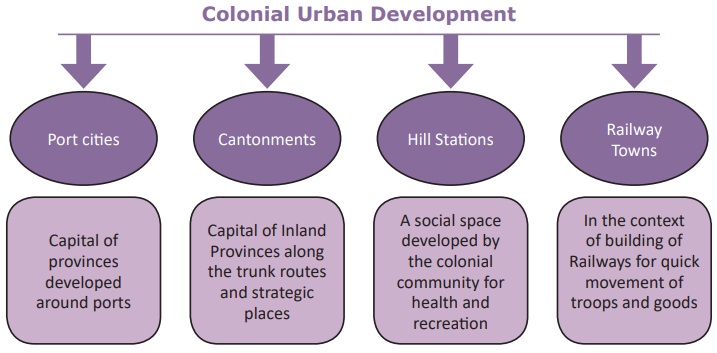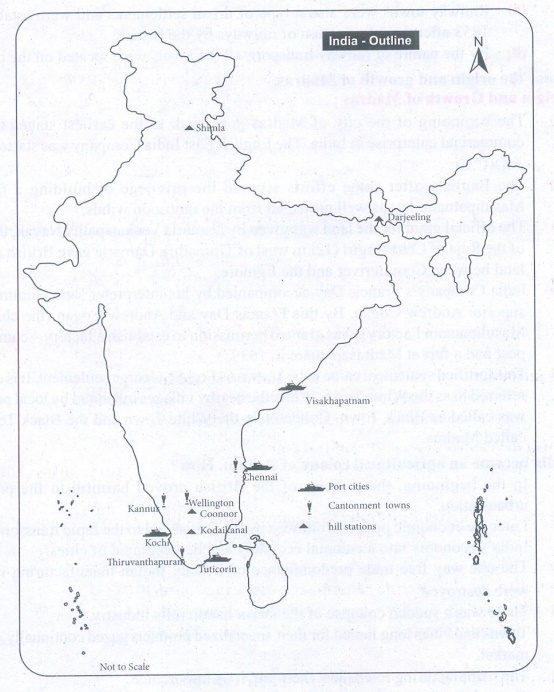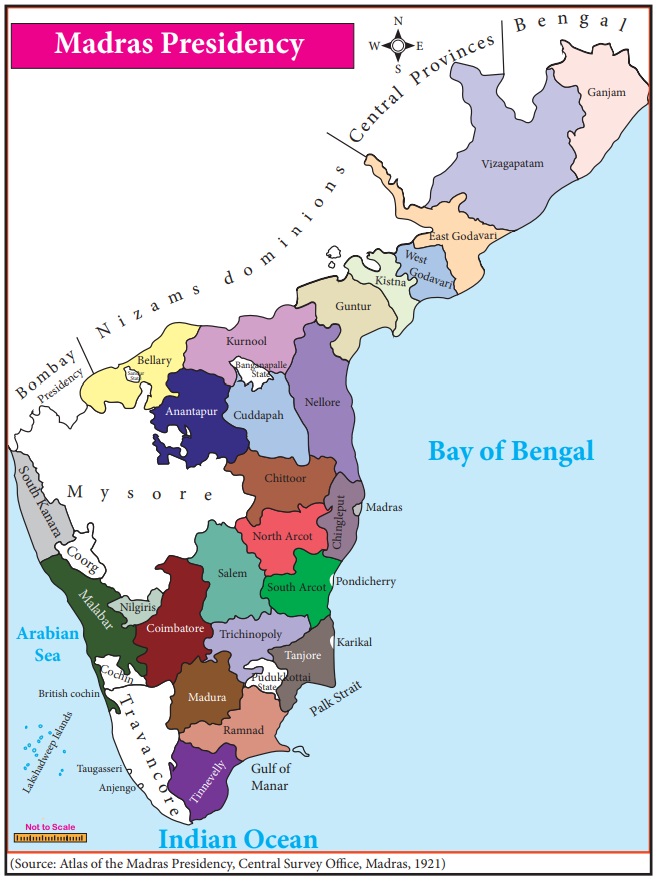Urban changes during the British period | Chapter 7 | History | 8th Social Science - Questions with Answers | 8th Social Science : History : Chapter 7 : Urban changes during the British period
Chapter: 8th Social Science : History : Chapter 7 : Urban changes during the British period
Questions with Answers
Evaluation
I Choose the correct
answer
1. Ancient
towns are
a. Harappa and Mohenjodaro
b. Delhi and Hyderabad
c. Bombay and Calcutta
d. None of the above
[Answer:
a) Harappa and Mohenjodaro]
2. Coastal towns developed by the British were
a. Surat
b. Goa
c. Bombay
d. All of these
[Answer:
d) All of these]
3. A new trend of urbanisation began in the latter half of
19th century as a result of
a. Opening of Suez Canal
b. Introduction of steam navigation
c. Construction of railways
d. All the above
[Answer:
d) All the above]
4. The British arrived India
a. for trading
b. for preaching their religion
c. for working
d. for ruling
[Answer:
a) for trading]
5. Fort St. George was constructed by the British in
a. Bombay
b. Cuddalore
c. Madras
d. Calcutta
[Answer:
c) Madras]
6. Which of the following port was the East India Company’s
principal settlement until 1774?
a. Fort William
b. Fort St. David
c. Fort St. George
d. None of these
[Answer:
c) Fort St. George]
II Fill in the blanks
1. The network of railroads in India
was introduced in 1853.
2. Ripon
rightly regarded as the Father of Local Self - Government in India.
3. The Government of India Act of
1919 introduced Dyarchy
in the provinces.
4. Sir Josiah Child was responsible for the formation of the corporation.
5. Francis Day and Andrew Cogan got
permission to establish a factory – cum trading post at madrasapatnam in 1639.
III Match the
following
1. Bombay - Religious centres
2. Cantonment towns - hill stations
3. kedarnath - Ancient town
4. Darjeeling - seven island
5. Madurai – Kanpur
Answer:
1. Bombay
- Seven island
2.
Cantonment towns - Kanpur
3.
Kedarnath - Religious centres
4.
Darjeeling - Hill stations
5.
Madurai - Ancient town
IV State true or false
1. Towns flourished since
pre-historic times in India. [Answer: True]
2. British acquired political
control after the Battle of Plassey. [Answer: True]
3. Fort William is in Madras. [Answer: False]
Correct
statement: Fort Williams is in Calcutta.
4. Army people began to live in
cantonments. [Answer: True]
5. Madras was officially renamed as
Chennai in 1998. [Answer: False]
Correct
statement: Madras was officially renamed as
Chennai on 17th July 1996
V. Choose the correct
statement
1. Assertion: India became the agricultural colony of Britain.
Reason:
The one-way free trade policy followed by British and the Industrial revolution
destroyed Indian indigenous industries.
a. A is correct and R is Wrong
b. A is wrong and R is Correct
c. A is correct and R explains A
d. A is correct and R does not
explain A
[Answer:
c) A is correct and R explains A]
2. Which of the following
statement(s) is/are not true?
i. Srirangarayalu gave the English
the grant of Madrasapatnam.
ii.Day and Cogan were jointly
responsible for the construction of Fort St. George.
iii. In 1969 the state of Madras was
rechristened as Tamil Nadu.
a. i only
b. i and ii
c. ii and iii
d. iii only
[Answer:
a) i only]
3. Assertion (A): British built up their alternative capitals in hilly
areas.
Reason (R): They found the Indian summer inhospitable.
a. A is correct and R is Wrong
b. A is wrong and R is Correct
c. A is correct and R explains A
d. A is correct and R does not
explain A
[Answer:
c) A is correct and R explains A]
VI Answer the
following in one or two sentences
1. What is an urban area?
Answer: An urban area is one that has a high population density engaged
in occupations other than food production, living in a highly built
environment.
2. Hilly areas were distinctive features of colonial urban
development. Why?
Answer:
(i) The British coming from a cool temperate climate, found the
hill stations protective from hot weather and epidemics.
(ii) So they built up the alternative capitals in cool areas.
(iii) So highly hills areas were distinctive features of
colonial urban development.
3. Name the three Presidency cities?
Answer: In the late 18th century Calcutta, Bombay and Madras rose as
Presidency cities.
4. State any four reason for the new trend of urbanization
in the 19th century.
Answer:
(i) The causes for the new trend of urbanization in the 19th
century were
(ii) Opening of Suez Canal, introduction of steam navigation,
construction of Railways, Canals and harbours.
(iii) Growth of factory industries etc.
5. Write short note on Cantonment towns.
Answer:
(i) Since the British needed strong military camps and
established the cantonment towns.
(ii) Army people began to live in these places and gradually
they were grown up into a city.
(iii) E.g. Kanpur and Lahore.
6. What were the regions covered in the Madras presidency
during British regime?
Answer: The region covered in the Madras Presidency during the British
regime covered were
(i) Modern day Tamil Nadu,
(ii) The Lakshadweep Island
(iii) Northern Kerala
(iv) Rayalaseema
(v) Coastal Andhra
(vi) Districts of Karnataka and various districts of southern
Odisha.
VII Answer the
following in detail
1. Describe the colonial urban development.
Answer:

(i) Port
cities:
(a) The British arrived in India for trading. Madras, Calcutta
and Bombay became the important ports. They played important role in trade.
These cities became the prominent commercial areas with tall European - styled
buildings.
(b) Fort St. George in
Madras and Fort St. William in Calcutta were the best examples.
(ii)
Cantonment towns
(a) The British occupied the Indian territory and political
power by their military force. So they needed strong military camps and
established the cantonments
(b) For e.g. Kanpur, Lahore.
(iii)
Hill Stations:
(a) Hill stations were distinctive features of colonial urban
development. Although Hill stations were not unknown, prior to their founding
by the British in India, they were few and had a small population and were
often visited for specific purpose.
(b) For e.g. Srinagar was a Mughal recreational centre,
Kedarnath and Badrinath were Hindu religious Centres.
(iv)
Railway towns:
(a) Railway towns were also a type of urban settlements and were
established in 1853 after the introduction of railways by the British.
(b) By the nature of railway transport, all the towns were
located on the plains.
2. Trace the origin and growth of Madras.
Answer:
Origin
and Growth of Madras :
(a) The beginning of the city of Madras goes back to the earliest
stages of British commercial enterprise in India. The English East India
Company was started in 1600 A.D (C.E).
(b) The English, after some efforts secured the privilege of
building a factory at Masulipatnam. It was well protected from the monsoon
winds.
(c) The official grant for the land was given by Damarla
Venkatapathy Nayak, the deputy of the Raja of Chandragiri (12km west of
Tirupathi). Damarla gave British a piece of land between Cooum river and the
Egmore.
(d) India Company’s Francis Day accompanied by his interpreter
Beri Thimmappa and superior Andrew Cogan. By this Francis Day and Andrew Cogan
(the chief of the Masulipatnam Factory), was granted permission to establish a
factory - cum - trading post and a fort at Madrasapatnam in 1639.
(e) This fortified settlement came to be known as Fort St.
George settlement. It is otherwise referred to as the White Town. While the
nearby villages inhabited by local population was called as Black Town.
Collectively the White Town and the Black Town were called Madras.
3. India became an agricultural colony of Britain. How?
Answer:
(i) In the beginning, the policies of the British proved harmful
to the process of urbanisation.
(ii) Later the economic policies followed by the British led to
the rapid transformation of India’s economy into a colonial economy and
development of cities.
(iii) The one way free trade predominance of British, Indian
manufacturing industries were destroyed.
(iv) There was a sudden collapse of the urban handicrafts
industry.
(v) Towns and cities long famed for their specialized products
gazed continually shrinking market.
(vi) The manufacturing towns lost their previous importance.
(vii) The industrial revolution, high import duties and other
restrictions imposed on the import of Indian goods into Britain and Europe led
to the decline of Indian industries.
(viii) Thus, India became the agricultural colony of Britians.
VIII Project and
Activity
1. Make an album – ‘Making of Chennai’ (from early period till now)
2. Mark port cities, cantonment towns, hill stations on the
outline map of India. (any four places from each)


Related Topics